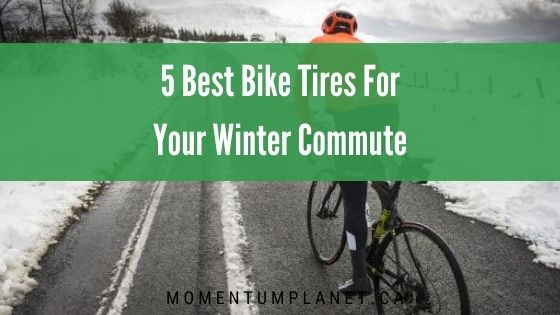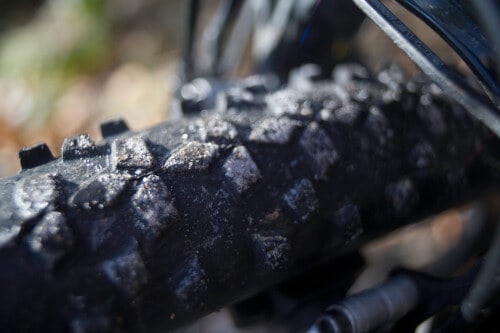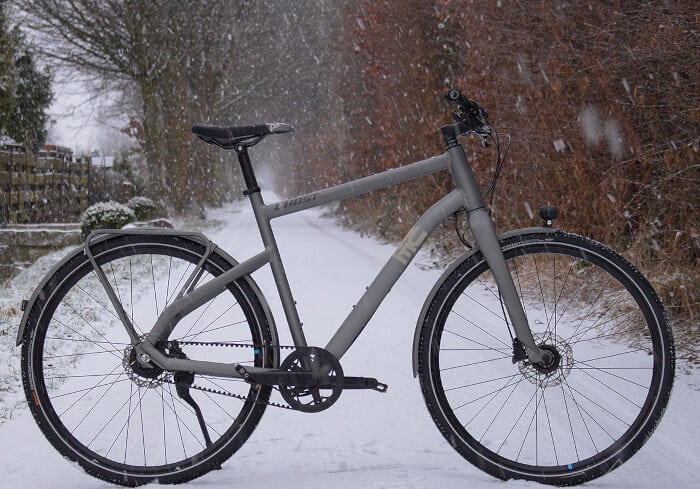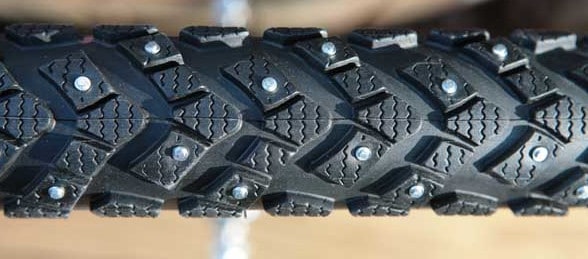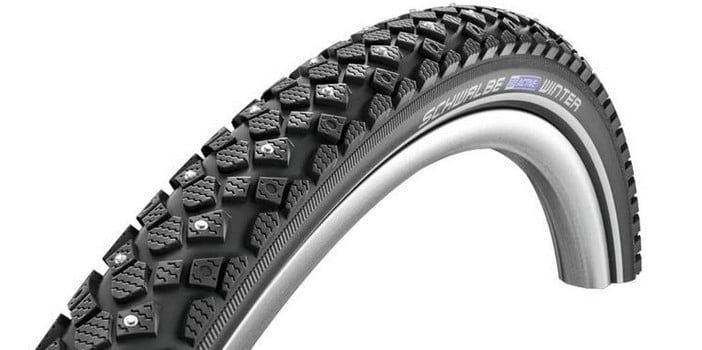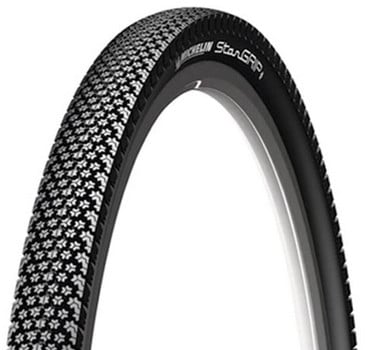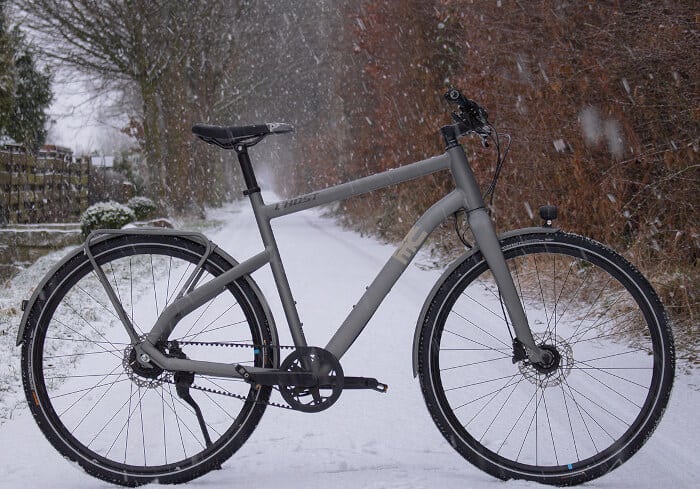Commuting by bicycle in a wintry wonderland? Just as you might outfit a car with snow tires, you may need to swap your skinny tires for some sturdier, studded bike tires for traction on icy surfaces. One thing is certain: you should not attempt to ride on ice without studded tires. I sometimes learn from experience.
As you are aware, snow changes in consistency from the time it floats from the sky, settles to the ground, is packed underfoot or flattened by vehicle traffic, and through its many cycles of melting and refreezing. Snow at 0 degrees Celsius is very different from snow at -15 degrees Celsius. Accordingly, these varying snow conditions will affect the behaviour of your bicycle tires on your daily commute. So which tire(s) do you choose for your winter ride to work or the grocery store?
Skinny Tires or Fat for Winter Commuting?
If you are reading this and wondering about which tires to use, I’ll assume your winter is snowy and you’ll be riding in variable terrain. Winter riding is very similar to mountain biking, and as with mountainous terrain, an all-terrain tire is what you want.
Note: This article will focus on winter tires for road or cyclocross bikes commuting in mostly urban areas. If you commute over really rough terrain or chronically unplowed roads, you likely ride a mountain bike with the fork clearance to run fatter tires than the ones I recommend below for typical commuter bikes.
Skinnies will cut through hopelessly if the snow is loose and the ground is dry. If you have loose snow layered over packed snow, or loose over ice, you are still at a disadvantage. When the slush freezes you will get pushed around, hard.
When to Use Skinny Tires: If you live in an area with mild winters where the snow on the roads is always new snow, or the roads are consistently well-plowed, you might be fine with running skinny tires most of the time. However, if you take the roads less travelled and your town/city/area does not keep the roads or bike paths clear, a fatter tire will work much better and be more fun.
But if you are an early morning bike commuter, be alert for possible water run-off from the curb or sidewalk freezing into ice on the roads. Studded tires are best for icy conditions; the weight and noise of studded tires are well worth the safety and confidence they provide.
I ride my road bike (with 700 x 23 Slicks) and a commuter (a cyclocross bike with fenders (700 x 35 Studded Winter Tires) in the mild Vancouver winter.
A Summary of Observations Running Different Tires (Ranging from 700 x 23 Slicks on a road bike to 700 x 35 Studded Winter Tires on a cyclocross):
- Skinny road tires are fine when the streets are plowed and salted (cleared city streets). So not during actual winter days, especially not when your path involves descending down a bridge with a sharp right turn at the bottom where water likes to pool.
- Skinny road bike tires are fine so long as there is no substantial accumulation of snow (greater than 1 inch) on the road and there is no ice. When there is snow accumulation, you never really know if there is ice beneath the fluffy stuff. Not the kind of surprise I like at 4am.
- Non-studded fatter tires with knobs are superior to skinny tires for loosely packed snow with no ice, or for playing around in a field. These tires are relatively fine for trail use too, especially on fresh fallen snow, but not ideal for commuting on roads.
- Slushy conditions call for studded tires. You can never really be sure if there is ice covered by the slush and snow-covered portion of the street.
Go Big or Go Home
Get the fattest tires that will fit your frame; they require less air pressure (and air pressure drops in cold temperatures), and cover more surface area for greater stability.
Your bike’s clearance dictates the maximum size of knobby tire that will fit your bike, and your rims will need to be wide enough to accommodate the thicker rubber as well. Generally, older cyclocross bikes can fit up to about 700 x 45 tires; bring your bike into a shop and test out a few tire sizes before buying, just to make sure.
Tread Confidently
Find a tire that has a thicker tread and extra siping—the thin slits that bite into ice, snow or slush—as well as built-in puncture protection like foam inserts which fit between the tire and the tube (Tannus Armour’s foam inserts) to withstand debris that gets flushed into the roads.
I used to use an aggressive cyclocross tire for winter riding, and that worked well for most snow days and dry days in Vancouver. Cyclocross tires are more narrow than MTB tires, and thus by design will not hold as much mud (or snow) as the wider MTB patterns. If you do ride a mountain bike, choose a tire tread pattern that will cut through snow and throw the snow out again without getting snow packed between the knobs themselves.
Studs: Great Winter Riding Strategy
A cyclist’s main concern when commuting on main or residential roads would be the unpredictable grooves or ruts formed by refrozen snow on roads. These ruts are similar in strength to sun-baked mud on some fire-road tracks, but much more slippery. Plus, some fresh-fallen fluffy snow might be hiding ice underneath.
For very icy, uneven roads, more studs would be preferred, but the rolling resistance increases with the number of studs. Nokian A10 or Hakkapeliitta W106 are classically capable winter tires. For an all-around tire, Schwalbe Marathon Winter tires are a good balance between speed and grip, with 200 studs. 300 studs and the tires begin to feel “sticky” on bare road when winter conditions change.
All studded winter tires are going to have high rolling resistance, compared with fast summer tires: your 40-minute summer commute can easily become a 45-minute commute on studded tires. The difference is real, but getting to your destination without wiping out and needing to call someone for a ride or a new leg is more important than five or ten minutes.
I would recommend Schwalbe Marathon Winter or Winter Plus as a good, all-round tire.
Tire Air Pressure
A wheel’s ability to ride on different terrains can efficiently be altered by regulating the amount of tire pressure.
For snow, use lower pressure for better grip; for good road conditions, use higher pressure for higher speed.
Scared yet?
Fear not, for with the right tire and air pressure, the bike will seemingly float through it all, much similar to riding on loose gravel or sand. Well, close not quite.
Ignore the printed pressure ratings on the sidewalls of studded tires (and all bicycle tires); tire manufacturers know that most people hold the erroneous belief that the higher the pressure, the better the roll. Partly true, except the posted pressure ratings are based on some percentage of the highest pressure the tire will hold before blowing off the rim — not guaranteeing that your rim will withstand the force placed on the sidewall by your tire at that pressure, or that the ride at that pressure will necessarily be superior.
For now, use the following as a rough guide to air pressure:
The fatter the tire, the lower the psi you will want to inflate. For example, if a 57mm wide tire is rated for 60psi, at that pressure the rim’s sidewalls would be subject to extremely high loads and is likely to crack, unless reinforced by an extremely heavy rim.
The skinniest winter tire I recommend is the Nokian A10 700×32 or 30-622. 30 to 32mm wide. Use 60psi as the maximum pressure in this tire.
NOTE: If you are riding on a cleared road no snow or ice on the ground, don’t ride aggressively with studded tires. Riding hard with studs on pavement will wear the tread blocks of regular knobby tires and damage the studs (carbine studs don’t wear like steel, they rip). Take it easy on the clear patches.
How to Tell How Fat of a Tire Your Wheels Can Take
If you have 700c/29er wheel set, how knobby you can go will depend on your rim width and your clearance between the top of your tire and the frame and fork.
If you currently have 700×35 printed on the sidewall of your tires, the W106 700×45 will be 10mm taller and 5mm wider on each side of the tire, 10mm wider in all.
Without removing your current 700×35 tires, for example, you can do this to see if the W106 700×45 tires will fit your bike.
Check these three things:
- Fork clearance: Look at the top where the tire comes close to the fork curve; if you have only 10mm of clearance over the top of the tire, between the tire and the fork, the larger 700×45 tire will touch the frame, rendering your bike immobile. If your existing 700×35 tire gives you 20mm of clearance, the 700×45 W106 should leave you with 10mm of clearance. Anything less than 10mm between the upper fork and tire is not enough to be safe; but with any amount of clearance, it’s always possible for something to get thrown up between the tire and the fork crown and lock the front wheel, causing a crash. But with at least 10mm of space over the tire, you’re safe enough.
- Clearance between the sides of the tire and the fork blades: If there’s only 5mm of clearance on each side of your current tire (assuming 700×35 for this example), the wider 700×45 will be too big to fit your bike. Again, ideally aim for 10mm of space on each side of the tire, between the tire’s sidewall and the fork blades. If a tire becomes warped, if there isn’t enough clearance there, your tire will rub as you ride.
- Rear tire clearance: The rear tire comes close to the frame in two places: between the seat stays and the chain stays. To refresh your bike anatomy, the seat stays are the two tubes that go from the rear hub upwards towards the saddle; the chain stays are the two tubes that extend from the rear hub forwards towards the crankset, where your pedals attach. Aim for the same 10mm of clearance above the tire and on each side of the tire at those two locations in the rear as you do with the front tire at the fork. If your rear tire were to rub against your bike frame it would not be as dangerous as having the front tire rub on the fork, but it would be annoying and could result in a friction flat tire.
Install your new tires and check clearance again
Your existing 700×35 tire needs 20mm clearance above and 15mm clearance on each side for optimal clearance with the new fatter tires (700×45). If you’ve assessed your bike and decide to install a fatter winter tire, check the clearance again after switching in the new tires. Look carefully when you have the new fat tire installed and make sure there’s at least 10mm above the tire and 10mm on each side of the tire.
Riding With Two Different Sizes of Tires?
Finally, if you are competent with a spoke wrench and know your way around a wheel, you may be comfortable with choosing bigger tires that leave you with less than 10mm clearance on each side of your tires.
You might want a larger tire in the rear. If your rear tire gets locked by something between it and the frame while you’re riding, you’ll likely skid to a stop without falling — certainly not as dangerous a situation as having your front tire jam up. So, you might choose to take the lower risk of having a rear tire rub if it means better control in the snow.
You could ride safely with less clearance in the rear than in the front — but please don’t take the excessive risk of running a tire without enough clearance in the front! If your front wheel gets caught up by something jammed in the space between the fork and tire while you’re trying to navigate on ice, you will not be vertical for long.
Recommended Road Tires (With Studs) for Snow and Ice
As a commuter, riding in an icy winter isn’t all that different from riding in the autumn/spring, as long as you have studded tires. What makes a difference is how many studs you need for the everyday road conditions.
Hakkapeliitta W106 Tires
MOST AWESOME OF ALL WINTER COMMUTING TIRES: The Hakkapeliitta W106 tire is the most awesome of all winter commuting tires. It has 106 carbide studs but they are placed exactly where you need them for daily riding. The 35mm should fit any touring, hybrid, or cyclocross bike; 45mm might fit certain cyclocross bikes that have lots of clearance. The W106 is the perfect tire for commuting through snow and black ice on good roads.
Studs: 106 steel-carbide studs on the 700 x 35 tires.
The Hakkapeliittas are thin enough to cut through road slush, hard enough to have a decent roll (at 65ish psi), and studded enough to grab slick icy spots. Arguably these are the best studded tires on the market, and boast an aggressive tread pattern that eats through new-fallen snow. They are not the best for tons of accumulated snow or plow debris, however. Choose these for black ice and roads with hard-packed snow to experience the greatest performance benefit.
They give you a whole new feeling of riding in the winter.
Nokian A10 Tires
BEST TIRE FOR PLOWED, ICY URBAN COMMUTE: The Nokian A10, AKA “Stud”: For commuting in urban areas that are likely to be well-plowed, but also likely to have icy patches in the evening after a sunny day, the A10 has the lowest rolling resistance of any studded tire. It may not be as good in the snow as the W106, but to be real, most riders hardly ever ride through much snow accumulation unless they are riding for shear pleasure in a field. In winter, commuters mostly have to deal with ice.
Thin tires work especially well at cutting through an inch or less of fluffy snow. The icy ridges and ruts left by cars seems to be the main obstacle for A10 700×32 Nokians. Many who ride the A10s tout them as the best snow tire they’ve ever tried.
Studs: 72 (700 x 32) or 74 (700 x 40) carbide studs.
Speed: They don’t seem slow; my commute to work takes the exact same time as when I’m running slicks. Or maybe I’m just working harder. Either way, definitely worth the money.
Schwalbe Marathon Winter or Plus
The Schwalbe Marathon Winter tire is a fine all-around tire for snow and ice. This is the perfect tire if you want one tire to do everything. The difference between the original and the ‘Plus’ tires is the Plus have an extra layer of rubber (5mm thick) for puncture resistance between the tread and the casing, which makes these a little heavier.
As you can see, the Winter has studs in the center of the tread as well as to the sides of the tread. This gives you maximum traction on flat ice as well as in rutted ice. There’s nothing worse than having your tire literally stuck in a rut with no way to climb out. But with studs at the sides of the tread, the Winter can easily climb out of ruts.
It has more studs and a higher quality casing. The slightly shallower tread blocks make for less rolling resistance for the urban commuter, who will see mostly ice and not snow anyway.
Schwalbe Winter Tire
The Schwalbe Winter is great for straight cycling across glassy ice. This tire eliminates the studs off to the side of the tread that would help you climb out of icy ruts or corner well, so if you require extreme cornering capabilities, opt for the Marathon Winter tires instead. The Winter has half the amount of spikes as the Marathon but has essentially the same tread. If you’re always riding on plowed roads, and so never have to deal with icy ruts, you don’t really need the studs toward the sidewall of the tread anyway, and you can save some money.
Best Tires for Mixed Winter Conditions (Without Studs)
Michelin Star Grip 700c Winter Tire
If you would rather ride a stud-less tire that is capable in every imaginable condition, give the Michelin Star Grip winter tire a spin.
These tires are taller than their listed height, thanks to their super deep, star-shaped tread pattern, so be sure to measure your clearance between your fork and tire before and after installation.
As you can imagine, there is weight associated with all that tread, and if you are coming from slick or semi-slick tires, you will notice the difference.
Despite their weight, they’re relatively silent and roll well, even when running them on the lower end of the inflation range. They perform well even in dry conditions, and for the added comfort of 40-45psi, it doesn’t slow them down too much.
There is absolutely no reason to run these over 55psi.
The Michelin Star Grips have good traction on wet surfaces, and they handle surprisingly well in fresh snow up to around 6 inches! But beware in rutted, freeze-cycled snow and ice; there’s hardly any lug spacing on the tire shoulder, so they are helpless to claw their way out of ruts.
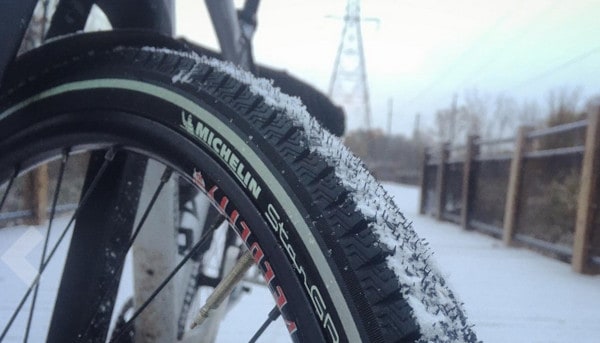
And since they lack the studs for sticking to black ice, they aren’t the greatest for quick commutes, but they still provide enough needed traction to keep you upright in multiple situations where a semi-slick or typical MTB tread would certainly not. So all that said, considering their price point, they get my endorsement without any doubt.
You might choose to install the studless Michelin Star Grip on the rear and pair it with a studded Swalbe on the front. This combination should handle well on ice and packed icy snow, and save a few bucks.
Top Contact Winter II Premium tires by Continental
If you ride a road or cyclocross bike as your winter commuter, you might like Continental’s Top Contact Winter II Premium tires (also suitable for e-bikes) with deep treads that grip slippery roads.
These tires are easy to install and handle a light covering of snow on roads or bridges with ease. As these are without studs, you may notice a bit of slippage going uphill on slush, but they are pretty stable overall and grip the road well. Depending on your road, on dry days the tires might pick up some small stones in the tread along the ride. The reflective stripes are great for commuting, too.
Front Wheel Winter Tire Only?
Sometimes you want to save a buck. I get it. You might think that one studded tire in front is sufficient. Yes, the scariest and quickest crash is often when the front tire loses its grip and you wipe out. If the rear tire slides you can still go down, but not as fast, and the results are usually not so disastrous, since you usually have enough time in slo-mo to support yourself with a sliding foot or perhaps a leg.
But with just a front studded tire upon which your life hangs, you can still go down hard. You can still not be able to climb up an icy hill. You can still spin out going downhill on a curved road or crash when trying to brake before entering a busy intersection. So, I can’t see any practical reason to use a single studded tire in front, except to save a few dollars. Until that decision costs more.
For the cyclist commuting on paved roads with the possibility of black ice, there really is no cheaper and better alternative to having the W106 or A10 on both wheels.
How Long Do Winter Tires Last?
Studded Tires: You can expect your studded tires to last you a good 2000-3000 miles. Instead of switching out your wheels with dedicated winter tires and summer tires each season, it is smart to check your tires every year or two to make sure the studs are not tearing or creating indentations or grooves in the inner tubes.
Winter Tire Tread: Your soft, grippy, deep-tread tires will last longer when you ride in the snowy conditions for which your tires were made. Riding on dry pavement or in warmer months will result in faster wear and thus shorten their lifespan.
Keep in mind that the rear bicycle tire carries more weight and will wear faster than the front tire.
